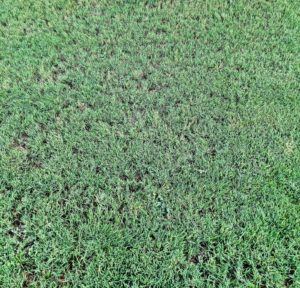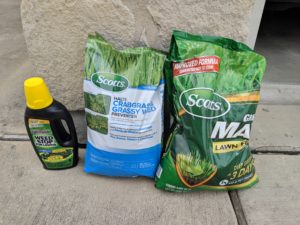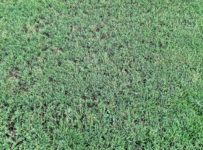February
Lawn scalping is when you cut your grass at a low level, so low that you expose the stems of your grass blades. Bermuda grass and zoysia grass should be mowed on the shortest setting in the early spring; however, St. Augustine, fescue, and centipede grass should NOT be scalped. I like to pre-scalp in February by cutting my lawn a layer lower than normal and completing the scalping by mowing another layer down in early March. I also apply a 10-10-10 fertilizer to gently add nutrients to the lawn but it is too early to fertilize with a stronger 16-4-8 fertilizer. Mow as needed to keep the lawn weeds in check.
When we gets spurts of warm weather in February and I see weeds, I like to apply a liquid post-emergent herbicide like Spectracide, Bayer Advanced, or Image. This will kill anything that made it past our pre-emergent applications. I find Spectracide works best on broad leaf weeds, Bayer Advaced works best on Crabgrass, and Image is the best at killing Nutsedge. Spectricide is the cheapest but it’s worth paying for one of the others if you have a particular issue with crab grass or Nutsedge. Also look at the ten day forecast when you do this and make sure it’s dry for a few days so that the herbicide isn’t immediately washed out.
March
Complete scalping if you haven’t already. When new grass is growing across all your lawn aerate and top dress your lawn. This can be done with a manual aerator or a gas powered one can be rented or the service purchased from one of our local lawn guys. Apply ½ inch of compost after the aeration. The compost penetrates the aeration holes to bring organic material into the root zone. You can substitute with a 10-10-10 fertilizer but compost is much better for the lawn after aeration.
Apply a pre-emergent herbicide to prevent summer weeds from germinating. This is especially important if you were bothered by sandburs and/or crabgrass. Andersons Barricade Professional-Grade Granular (Amazon), Scotts Halts (Amazon & Lowes)and Green Light Amaze (Amazon & Lowes) are good herbicides for the job. I have also found corn gluten meal (Amazon & Lowes) to be a good natural product for the job.
Check your irrigation system or call in your irrigation contractor to check out and repair your system. Make sure the rain sensor is working and all leaks are repaired.
Have your mower sharpened and the engine tuned up. Mow in March to keep the lawn weeds in check.
It’s also a good time to apply an insecticide. Previously I recommended Spectracide Triazicide as a cheap insecticide for surface insects. If that’s all you need to control then that will still work. If you would also like to prevent grubs in the lawn I find granules work best. Spectracide also provides the cheapest granule solution that works. If you want to pay a few more dollars BAYER ADVANCED has a liquid spray that also provides both surface insect and grub control. BAYER ADVANCED also has a granule that is rated well.
 April
April
Mowing really starts this month. Mow St. Augustine and Bermuda to 3 inches tall or shorter, zoysia to 2 inches tall and buffalo grass to 5 inches. Mow frequently enough that only one-third of the grass blade is removed at every mowing. Once per week is usually sufficient.
After you have mowed the lawn two times, it is time to fertilize the lawn. I like Andersons Professional PGF Complete (16-4-8) for this application but other lawn foods at your big box stores should work for this application.
Chlorotic (yellow) grass is a common symptom of St. Augustine grass. It appears in spring when the soil is too cool for the roots to pick up iron. Chlorosis will address itself with time and a change in weather or you can apply an iron chelate product by hose-end sprayer.
May
You will be stuck with the weekly watering recommendation provided by SAWS. Make sure to check the SAWS website for the latest watering schedule based on the aquifer level.
The winter weeds are trying to go to seed before the heat kills them. Keep the lawn mowed every week to reduce production of the weed seeds for next winter.
June
Make your second application of pre-emergent herbicide to prevent weeds that spring up after summer thunderstorms.
It is time to apply a soil insecticide if your lawn was attacked by grubs last year. The same insecticide will also control chinch bugs. Look to my March recommendations. To add to those recommendations Andersons DuoCide works really well on Grubs.
July
Watering is the key. Let SAWS’ recommendations be your guide. For especially hot areas such as along the sidewalk that seem to dry out, give them a little extra water by handheld hose.
August
Chinch bugs will make your lawn look moth eaten. The damage usually appears on the hottest part of the lawn. The lawn drying out will cause a similar symptom. Handwater the spots every day for two or three days. If the area does not green up, it is probably caused by chinch bugs. Apply a soil insecticide.
September
If dry continue watering to keep up with the heat.
If it’s a wet September discontinue watering in the evening and let the lawn go a little dry in order to prevent brown patch fungus. If it appears anyway, apply a treatment of a labeled soil fungicide.
Apply a fall fertilizer to help your lawn recover. I like a ratio of 16-4-8 in a liquid format before rain or watering the lawn. If using granular’s this is the last month to apply one as they last several months and you don’t want the fertilizer to just feed winter weeds when you lawn goes dorment.
October
Apply a pre-emergent herbicide to prevent winter weeds. Check the label to make sure the weeds you had last year in your yard are on the label. Rescue grass, bedstraw, dandelions, thistle, henbit and annual bluegrass are common.
November, December, January
Switch to a winter irrigation regime. Water every three weeks if it does not rain from now until May.
You should only have to mow every few weeks to control winter weeds.
If we get some warm weather and weeds go crazy apply a liquid post-emergent herbicide like Spectracide, Bayer Advanced, or Image. I find Spectracide works best on broad leaf weeds, Bayer Advaced works best on Crabgrass, and Image is the best at killing Nutsedge. Spectricide is the cheapest but it’s worth paying for one of the others if you have a particular issue with crab grass or Nutsedge. Also look at the ten day forecast when you do this and make sure it’s dry for a few days so that the herbicide isn’t immediately washed out.




